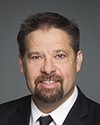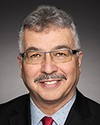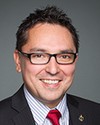Thank you, Mr. Chairman, and members of the committee. I thank you for inviting me here today.
I also would first like to acknowledge the Algonquin people on whose traditional ancestral homelands we are assembled today.
I have appeared before this committee and other standing committees in the past. This will be my first under this Liberal government. By way of introducing myself I am a treaty Mi'kmaq from the Millbrook First Nation in Nova Scotia. Throughout my life I have been involved in advocating for the rights of indigenous peoples and I intend to continue doing so for many years to come.
In 2000, I served as national chief of the Congress of Aboriginal Peoples for six years, up to 2006. I returned to the congress in 2011 when I was elected as vice-chief. I remained in that position for a year. In September 2015, I was re-elected for the fourth time as national chief of the Congress of Aboriginal Peoples. I am pleased to say that I am back.
For those of you who may not know us let me tell you a little about the organization. The Congress of Aboriginal Peoples is one of five national indigenous organizations that are recognized by the Government of Canada, and it is recognized by provincial and territorial governments and by the international community as well. For 45 years, since 1971, the Congress of Aboriginal Peoples, formerly known as the Native Council of Canada, has been a national indigenous representative organization that has represented the interests of the Métis, off-reserve status Indians, and non-status indigenous peoples living in rural, remote, urban, and isolated areas throughout Canada, including the Inuit of southern Labrador.
CAP has been at the forefront of issues that matter most to indigenous peoples for many years. Here are some examples.
CAP fought to ensure that the word “Métis” was included in the Constitution during the constitutional talks of 1982. In fact, it was our former leader, Mr. Harry Daniels, who was widely accredited for getting Métis in the Constitution.
We were also successful in 1999 when the Supreme Court of Canada ruled on the Corbiere case declaring that all bands holding elections under the Indian Act would be required to extend voting rights to their band members living off reserve.
In January 2013, the Federal Court of Canada affirmed the position that CAP had fought for since 1971, that the Métis and non-status aboriginal people are Indians under section 91, class 24, of the Constitution Act of 1867. This historic ruling granted long overdue recognition and equality to over 600,000 of Canada's forgotten indigenous peoples. We now await a final decision from the Supreme Court.
Fundamentally, CAP seeks to ensure that all indigenous people have equal access to programs and services across the country and that our indigenous and treaty rights, as recognized under section 35 in Canada's Constitution Act of 1982, are given equal protection regardless of residence or Indian Act status.
I would also like to provide you with a quick overview of how the congress operates and what we do.
CAP works closely with its provincial-territorial organizations, referred to PTOs, and advocates on their behalf on the national level. Each of our PTOs is a provincially or territorially incorporated organization that provides research and advocacy support to their members and carries out a range of programs and services for their constituents.
In terms of our youth council, with the ever-growing indigenous youth population, CAP is committed to ensuring that the necessary tools and supports are in place to enable our youth to live successful and productive lives.
On the aboriginal skills and employment training strategy, ASETS, indigenous peoples face a number of challenges when entering the labour market, including constitutional, jurisdictional, and geographical gaps. The ASETS program, which started in 1999, fills those gaps by providing skills training, employment counselling, wage subsidies, and self-employment assistance.
Regarding our third annual national grassroots engagement tour, the grassroots engagement tour is an opportunity for indigenous peoples living off reserve in rural and urban areas to engage in town hall-style events and discuss the issues that matter most to them. This year's tour began in Victoria, B.C., and to date we have made nine stops in communities across Canada. Another 13 town halls are scheduled or in the planning stages in the coming weeks. From these sessions we have identified themes that best represent the concerns of our constituents including housing, education, and the Harry Daniels court challenge that is before the Supreme Court.
Now I would like to turn our attention to the promises made in the Liberal platform during this recent election. We are hopeful that this government wants a renewed relationship that includes all indigenous peoples, regardless of where they choose to live. The congress is also committed to working in close partnership with the government and all national, regional, and community indigenous organizations to bring about the much-needed change in recognition for our indigenous peoples.
This is what real partnership must look like. Prime Minister Justin Trudeau promised real change. The Prime Minister also committed to a new nation-to-nation process that will renew the relations between Canada and all indigenous peoples. In fact, the mandate letters that went out to all cabinet ministers contained specific priorities and directives for each portfolio, and also wording on the Prime Minister's overall expectations.
Let me read one excerpt:
I made a personal commitment to bring new leadership and a new tone to Ottawa.... No relationship is more important to me and to Canada than the one with Indigenous Peoples. It is time for a renewed, nation-to-nation relationship with Indigenous Peoples, based on recognition of rights, respect, co-operation, and partnership.
I also want to reiterate what we have said in the past with respect to nationhood. Traditionally, the indigenous peoples in Canada identified with their own specific nations of peoples, such as mine which is Mi'kmaq. There are Maliseet, Mohawk, Ojibwa, Chipewyan, and there are many more. These are examples of some of the 60 or so nations of indigenous peoples in Canada. The reality is that indigenous nations of peoples have been systematically divided by the federal government through Indian policy, the disinheritance of indigenous peoples' birthright, identity, and the dispossessing of access to their lands and their resources.
Today we have countless classifications for Indian, far too many, and far too confusing. For example, we have status Indians, non-status Indians, off-reserve Indians, on-reserve Indians, registered Indians, treaty Indians, band members, non-band members, beneficiaries, non-beneficiaries, and so on. This list now includes distinct and non-distinct classifications of who is an Indian.
Who is an Indian, or an aboriginal or indigenous person? The definition is very clear under section 35 of the Constitution Act. It says, “'aboriginal peoples of Canada' includes the Indian, Inuit and Métis peoples of Canada”.
The Constitution was meant to be inclusive, not exclusive. However, under this new government's commitment to a nation-to-nation relationship with indigenous peoples across Canada, the big question being asked by many of our people is where do urban and rural indigenous people fit into the government's concept of nation-to-nation relationships.
On December 13, 2015, Christine Martin, the executive director of the Vancouver Aboriginal Transformative Justice Services Society, said to a CBC Vancouver radio host:
I'm not going to lie, I think we're a little concerned about how this is going to roll out in the urban aboriginal community. It leaves out a huge population of approximately 65 per cent of us who don't live on our reserves, and not many of us have connections to the bands that we come from. Some of our people who live here in Vancouver have never been to the band that they come from, let alone be active participants in it.










